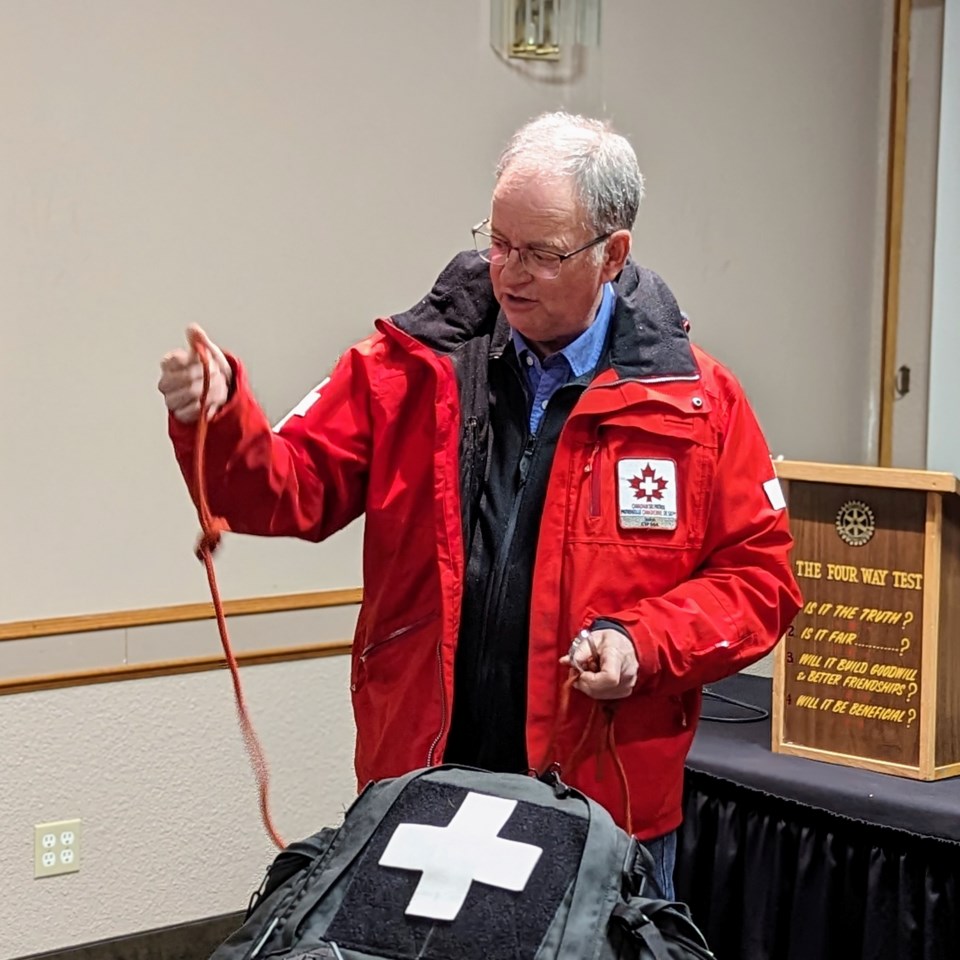John Humbert, VP of patrol development with the Canadian Ski Patrol and a member of the volunteer first aid organization since 1975, joined the Rotary Club of Moose Jaw for a presentation on March 20.
Humbert was only 18 when he joined the Canadian Ski Patrol, shortly before being posted by the military to Moose Jaw. He put in at least 25 seasons as a ski patroller at the now-closed White Track Ski Resort, and described his ski patrol activities as a lifelong hobby.
“White Track closed in 2008, I think, so I’ve just kept doing my ski patrol hobby in Fort Qu’Appelle,” Humbert explained. “The Ski Patrol is a Canadian organization. It parallels that of the national ski patrol in the United States. There’s about 4,500 members across Canada, all volunteers. We have about 110 members here in Saskatchewan, and we serve the ski community both Alpine and Nordic.”
Saskatchewan ski patrol members are responsible for six winter sport areas in the province:
- Mission Ridge Winter Park, near Fort Qu’Appelle, SK
- Table Mountain Ski Resort, near North Battleford, SK
- Mount Joy Snow Resort, near Lloydminster, SK
- Duck Mountain Ski Area, near Kamsack, SK
- Wapiti Valley Ski and Board Resort, near Melfort, SK
- Asessippi Ski Area and Resort, near Russel, MB
Humbert said that because of Mount Joy, which is partly in Alberta, and Wapiti Valley across the Manitoba border, the Saskatchewan Ski Patrol has three provincial bodies whose regulations they must comply with, which keeps things interesting.
They also requently volunteer at other winter sport events such as the Sask Winter Games.
“There’s a couple of reasons I keep doing it,” Humbert said. “One of them is that there’s some wonderful people in the organization, some really fine people who are part of it, and they’re good friends of mine. And I wouldn’t see them otherwise.
“The other thing is, if I didn’t have ski patrol to do, I probably wouldn’t get out skiing very often.”
Humbert disassembled his official ski patrol pack, showing the various first aid items and necessary supplies he takes with him onto the slopes. He’s accumulated decades of experience responding to emergency situations of all kinds — for example, broken bones from falls, bleeding traumas from collisions, and, of course, rescuing skiers and snowboarders who have become exhausted and unable to continue.
The necessary certifications for a ski patroller need to be maintained and demonstrated every year. Members must know how to perform CPR, use automatic external defibrillators and barrier devices, and much more. They also must be good skiers or snowboarders.
“There’s a battery of exams, a written exam, several practical exams, skills, demonstrations and what-have-you. And we do the recertification process every year,” Humbert said. Like other organizations solely composed of volunteers, the Saskatchewan Ski Patrol is always looking for new members.
Potential recruits must be at least 18 and be willing to acquire and maintain the necessary First Aid certifications. Volunteering could even lead to a job on a professional team.
Email [email protected] for more information or talk to a ski patrol member at your local winter park.
“We’re all volunteers and we have no minimum amount that people need to be involved,” Humbert added. “If they could come out to the ski hill maybe 10 times a year, that would be great.”




